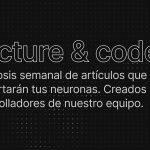Surely you have been seeing in recent months how a multitude of Artificial Intelligence consulting firms are emerging, many of them emerging from nothing but of course, the question that arises is: What exactly is an AI consultancy? And from that question, many others arise: What benefits does it offer me? How much does it cost? Is it really going to be useful? How long will it take me to implement the technology? How many people will I need to train to introduce it in the day-to-day running of my company?

These and many other questions need to be answered in an AI consultancy. Let's take a look at the key points below. But, in addition, I advance you a great news, as we told you in an article recently, if you have a company between 10 and 250 employees you are in a perfect time to make this FREE consultancy thanks to the consulting kit. In this article you have much more information -> «Do you know how Kit consulting can help you ride the artificial intelligence wave?«
But let's not beat around the bush, let's describe what elements this consultancy consists of and how it should be structured to be really effective.
1. Initial assessment of the Artificial Intelligence consultancy.
The first thing is to analyze your company, the degree of digitalization and, of course, the normal processes and operations performed by the different departments on a day-to-day basis.
This previous analysis will help us to identify areas and processes where generative AI could have a significant impact. Each department usually works in a different way and surely all of them can be automated in one way or another depending on your industry, your audience, your marketing strategy. In all of them there are ways in which you can lighten some of the heaviest work using artificial intelligence models.
2. Identification of use cases for the business:
The previous analysis will have already given us some clues, but now is when, within the identified areas, we will identify exact use cases where you can use generative AI tools to optimize processes.
Let's stop talking in the abstract, surely your marketing department will need tools to create content and images. Your HR department will need classification tools to quickly detect several candidates that are a good fit for a position among the hundreds of CVs you have stored for months or years. Your sales department can probably benefit from predictive models, etc... These are just a few examples, there are many possible use cases, our job is to see which ones can be easily implemented in your company.
3. Strategy Development:
Obviously, we cannot introduce all the tools overnight. For an effective assimilation by the enterprise, this is a gradual process. This is where you need to work on the reation of a generative AI implementation strategy aligned with business objectives.
This is where we will prioritize the specific use cases that have been identified in the previous point. Here we will normally draw a timeline and define which of the cases will be covered first and how it will be done.
4. Selection of technologies and models
As you probably already know, today we have a multitude of generative AI tools that can help us cover those use cases that we have already identified and planned. Precisely one of the big problems we have at the moment is the huge fragmentation of these tools.
We certainly don't want to have 15 different tools within our organization, that approach is not very operational on a day-to-day basis. This is an important part, advising on the selection of the most appropriate generative AI tools and platforms, as well as their adaptation and unification so that it is simple and convenient to use them within the company.
5. Technological integration
Now we come to the fun part, the implementation of the plan. We must integrate the tools that we have previously planned and, in this first phase, make a kind of «micro training» for the models to adapt to the way of working of the company.
6. Training and education
We have reached a critical point in the implementation of generative AI within the company. It does not make much sense to implement all these tools if people do not use them. A series of training programs must be established for the company's personnel in the use and management of the generative AI tools to be implemented.
Something to keep in mind that is rarely given importance is the development of internal skills for the maintenance and continuous improvement of AI solutions. Let's not forget that AI can evolve with the daily use of the tool. Depending on the architecture we choose, we can have a system that gradually adapts better and better to the way it is used within the company, but of course, we must take this into account beforehand and integrate it so that this is the case.
7. Monitoring and evaluation
Within this consultancy it is very useful to establish metrics and KPIs to evaluate the impact of generative AI in the company.
Continuous monitoring of the performance of the implemented solutions will allow us to adjust how we use these tools and evolve their use within our organization. Something as dynamic as AI cannot be left stagnant, its use and improvement will be key to get the most out of it over time.
8. Support and maintenance
Of course, a technical support and maintenance plan for generative AI solutions is a must. This is software and, like any other tool we use at the corporate level, requires a subsequent maintenance plan without which the tools may fail or become obsolete. This is also a critical part of our Artificial Intelligence consulting.
Let's not forget also the evolution of the models, this will be another important point when preparing this maintenance and support plan.

In short, these services would ensure an effective and sustainable implementation of generative artificial intelligence within your company, thus improving efficiency, competitiveness and innovation capacity. It is not about saving costs, it is about optimizing resources and, let's not fool ourselves, increasing turnover and the operating margin with which we move in the company.
If you want more information and you are interested in seeing how you can have this consultancy for FREE, just contact us through the following form, we are very involved in this type of implementations and we are sure we will find a way to help you.


